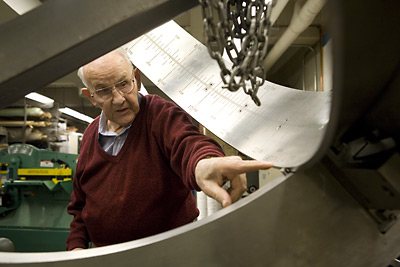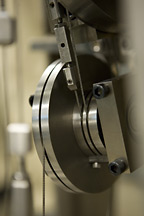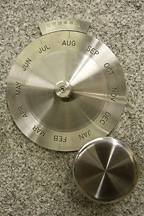Rustproofing and better design ready sundial for return to the Engineering Quad
By Anne Ju

Anyone who has missed the large, silver-metallic sundial that normally graces the Joseph N. Pew Engineering Quad should be glad to know it will work better than ever when it returns in coming weeks. It will even be rustproof.
Since early September, the sundial's co-designer and builder, Cornell President Emeritus Dale Corson, and scientific instrument maker Rodney Bowman have been preparing the sundial for its next quarter-century and beyond. The sundial was moved this fall from the Quad to Clark Hall's basement machine shop where it has been undergoing minor redesigns and repairs, with some help from computer technology to improve its precision.


Corson built the sundial in 1980, three years after retiring as Cornell's eighth president. He shares credit for its intricate design with Professor Emeritus Richard Phelan, who created the mechanism in its base that allows it to read clock time.
"This is my legacy to Cornell," Corson said. He shares that legacy with Phelan, Corson added, and now with Bowman, who made the new parts.
During the sundial's hiatus these past months, Bowman cleaned up some small rusted components of the 650-pound sundial, which had to be taken apart to be moved across campus. Some of those pieces were sent to a workshop in Syracuse to be chrome-plated for rustproofing, Corson said.
The heart of the sundial's functionality, a roundish steel disc called a cam, was also replaced with a stainless steel, slightly better-functioning one, connected to an hour and minute scale by small, stainless steel cables via a pair of precisely designed pulleys. This setup enables the instrument to read clock time.
Last winter, Corson and others noticed that the date could no longer be set on the instrument, which, after inspection, was found to be the result of rust and corrosion, primarily in the cam.
Though the sundial now sits in the basement of Clark Hall fully intact, it must again be disassembled to be moved back to the Quad. Bowman and Corson still have some calibrations to finish, but Corson said he feels that, overall, they have made the sundial a better timepiece.
"We have had the advantage of 25 years of experience with it, and the machines that made some new parts, like the cam, are better machines now than we had available 25 years ago," Corson said.
Media Contact
Get Cornell news delivered right to your inbox.
Subscribe